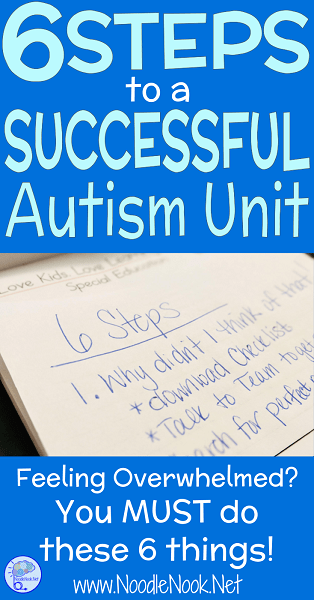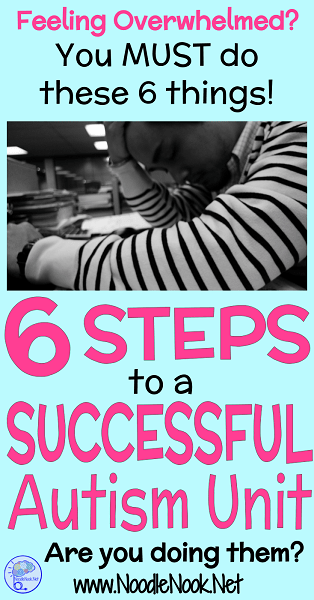6 Steps to a Successful Autism Unit
I can tell you right now, if you are NOT doing these 6 things in your Autism Unit or LID (low incidence disabilities) classroom, then you are going to have problems all year… I guarantee it. There are just some things you have to do to make things run smoothly… so, are you wondering what those things are?
#1: Plan Your Opening Routine
A consistent routine will be THE life saver for you in your Autism Unit. I do a lot of classroom visits, and the one thing I see over and over again is this: the bell is ringing and a classroom full of students are waiting for the teacher, who is caught with a behavior problem, parent phone call, para question, or even a (very rare) bathroom break. The first ten minutes of class there are always little fires to be put out. Having a great and consistent opening routine that the students do every day without fail will give them predictability and buy you a few minutes to extinguish all the fires.
#2: Create and Post A Visual Schedule (And Use Timers)
Having a schedule that students, paras, and you can all see really does help to keep a class on task, continue to maintain the consistency we laid out in step 1, and also ensure you get everything done. This happened to me a million times in my early years as a teacher. My class starts an activity and it just takes longer than expected to get through it all. Suddenly, we have no time for math (and I miss all that IEP data), or we’re rushing to clean up for lunch. If you need to, use timers to keep you on track. And for you super-superstar teachers, manage the transitions with a plan and a routine – it will help to define the new topics and also help students to mentally end one thing and move on to the next. Remember, you may also need individual student schedules on desks for student access. Read more about visual schedules and other visuals that can support you in the classroom. If this is something you struggle with, check out the online course we offer to better manage behavior… it spends an entire module on visual supports and which ones to use and when.
Never seem to be able to find a working timer in your classroom? Here are a couple of online FREE timers you can post in your classroom… or you can always type TIMER into the Google search bar and a timer will pop up! I personally love and use Classroom Screen because it doesn’t have any ads or distractions to get in the way or pull student attention.
#3: Define The Spaces In Your Classroom
A good classroom setup is so important. There is something to Feng Shui – and you need to lay out a lot of flexible spaces when you’re working with students with disabilities. I suggest having at least one area for 1:1 instruction and assessment, another area designated as a behavior area or cool-down spot, another for small group (and remember to make room for wheelchairs and maneuvering equipment), and at least one area designated for centers or independent workstations. A lot of what you need will depend on the level of your students, the space you have, and the subjects you are teaching.
There is a great, GREAT checklist here for teachers to think through and plan a Self-Contained or Autism Unit. Totally worth the effort… you will not forget anything with this at your side! You can also read more about setting up good physical space in your classroom here. Planning is important… so if you’re looking around your classroom and wondering how to make it all work better, start with defining some spaces.
#4: Have Students Interact In a Meaningful Way
This one is a pet peeve of mine. I do classroom visits and see all the students together, but no one talking. Most students with multiple disabilities have a hard time with appropriate social interactions, yet in the classroom it seems the only people they are talking to are the teachers and the paras. Setting up a cooperative learning environment or at the very least activities where there is peer to peer interactions goes a long way. You can read more about that here, and there is even a printable freebie to set up Kagan Method Table Tops!
Even if you don’t buy into Cooperative Learning for your students, you have to consider how to increase social interaction. Check out this post to read more on social skills for students with disabilities HERE. I also suggest social stories that target social interactions and social skills for all students- building those abilities will make overall socialization better.
#5: Focus On Reusable Activities
I see a lot of teachers spend a lot of energy making a crap ton of activities that cannot be used a lot. When you tailor an activity to one specific topic or one specific student, you are actually hurting yourself and your students. A great example of this is communication boards. I see teachers make new communication boards for every topic the class discusses, but a student with multiple disabilities often can’t master a new board every week, month, or unit. Giving a single broad based board used over time can really be mastered.
Think of that when you create materials- can this be reused? Can it apply across multiple activities? Can my student use it or the skill it teaches after graduation? The NoodleNook store is FULL of materials that will allow you to prep once and reuse often. Some of my favorites are the Adapted Books, Adapted Novels, and Writing Stems (Check out this FREE Math Activity HERE). You can reuse those and even target different skills with different goals using the same materials… plus everyone loves menu math activities – practicing money with food from your favorite restaurants is super motivational and that makes it more meaningful!
#6: Procedure, Procedure, Procedure
Whenever struggling teachers observed me teaching, they asked me how I do it.
How?
The answer is simple.
For the first month (sometimes more) we focus on procedures. We still did academics and functional activities, but the point was to establish the procedures and routine. My expectations were high and I needed everyone on board. But what the early focus on routine does is open up my time later in the year to work on the skills my students need most – because they know what to do. What to do when they get to class, what to do on Mondays, what to do when a student has behavior in class, what to do when they can’t spell a word… there was a procedure for everything (and it typically did not involve me – that way I was always free to teach, do data, or manage the behavior problem).
I am telling you, it can be done and be done efficiently. If you are in doubt even a little bit, please get the Ultimate Checklist. You will see all the steps I use in setting up every year and it comes complete with all the procedures you need and a set of great templates. It is the one thing you need to start your year off right!
Be Easy on Yourself
My old boss used to say that on the first day the job was to “get ‘em off the bus, feed ‘em, and get ‘em back on the bus”. Don’t be too hard on yourself. I know you have high expectations, but on the first day also have realistic expectations.
You will be a Rock Star, so if you have questions about what was listed above, post it in the comments. And if you have a great tip for new or vet Autism Unit Teachers or LID teachers, please post them as well to keep the conversation going.
This is a revised reposting of the original 6 Ways to Start the Year off Right When Teaching Students With Multiple Disabilities.




